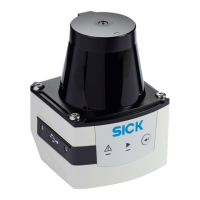8015886/Z713/2016-10-10 •
Subject to change without notice
•
SICK AG
•
Waldkirch
•
Germany
•
www.sick.com
TiM55x/TiM56x/TiM57x | S i C K
联系人:胡工 18714820727
OPERAT i NG i NS TR UCT i O NS
operating instructions may contain passages of text in a
supply voltage does not drop below 8 V for longer than 2
ms and never rises above 30 V.
Ranging Laser Scanner
Short Range
Correct use
The TiM55x/TiM56x laser scanner (referred to as the TiM
below) is intended for useas a non-contact measurement
sensor in standalone operation. It measures radial distances
within a flat surface (circle segment) depending on reflectivity.
The
T
iM
displa
y
s
t
he
measured v
alues
of
t
he
r
ecorded
en
vi
-
r
onment cont
our of its
scanning angle
of
270°
o
ver
t
he
Et
her
-
net or USB interface for further processing as either a one-off
orcontinuouslyonrequest. Thisrequiresacorresponding
driver to be created by the user.
The device is designed for portable or stationary use indoors
or outdoors in standalone operation, with a scanning range
of up to 10m.
The purpose of this instruction manual is to allow you to put
the TiM into operation quickly and easily and to achieve the
first measured value outputs and the first detection results.
F
ur
t
her
inf
or
mation
on
t
he
mechanical and electrical ins
t
al
-
lationaswellasonthe measuredvalue outputisavailable in
the
TechnicalInformation (Nr.8015883)
.This information
is available for download on the TiM product page
(www.sick.
com/tim5xx).
The TiM is certified to IEC/EN/UL/CSA 61010-1:2007. These
Safety information
•
Read these instructions before commissioning the TiM
inorder tofamiliarizeyourselfwith thedevice and its
functions.
•
TheTiMcorrespondstolaserclass1( see“Laserradia-
tion! Page 3”).
•
Mounting and electrical installation areto be performed
only by qualified technicians.
•
Electrical connections between the TiM and other devices
may only be created or fixed when thereis no powerto the
system. Otherwise, the devices may be damaged.
•
Conducting crosssections of the supply cable from the
cus
t
omer's
po
wer
sy
s
t
em should be designed
in
accor
-
dance with the applicable standards. Secure the TiM with
an external 0.8 A slow-blow fuse at the start of the supply
cable, from the perspective of the supply voltage.
•
Allcircuitsconnected tothe TiMmustbedesigned SELV
or PELV circuits. (SELV = Safety Extra Low Voltage, PELV =
Protective Extra Low Voltage).
•
Use the device only under permitted environmental
conditions (e.g. temperature, grounding potential, see
“Technical data Page3”).
•
T
ur
n
t
he
swivel connect
or
unit wit
h
t
he
electrical connec
-
tions max 180° from end position to end position.
•
Protect the TiM against moisture and dust when the cover
to the USB socket is open. The black plastic cover must
be screwed flush in order to comply with enclosure rating
IP 67 in operation.
•
Opening the screwsof the TiM housing willinvalidate any
warranty claims against SICK AG.
•
The
T
iM
does
no
t
cons
titut
e
personal
pro
t
ection e q
uip
-
ment in accordance with the respective applicable safety
standards for machines.
Commissioning and configuration
Step 1: Electrical installation
1.
Connect the communication interface of the TiM to the
PC (Ethernet or USB; recommended Ethernet, 4-pin M12
outlet).
>
Ifusinga USB, connecttheTiM's Micro USBport(behind
the black plastic cover on the side) to a free USB port (type
A)
on the PC using a suitable shielded high-speed USB
cable (e.g. no. 6036106, 2 m).
The USB cable may not exceed 3 m in length!
When
operating
t
he
USB
int
er
f
ace,
ESD/EMC
int
er
f
er
-
ences can lead to an interruption of the USB connection.
Tocontinue with the data transfer, disconnect the USB
cable from the TiMand reattach it to establish contact. To
re-establish communication between TiM and PC in the
SOPAS communication software, select
C
om muniCation
>
Go online .
2.
Turn on and start the PC.
Provide power to the TiM (5-pin M12 plug).
Using the power supply unit it must be ensured that the
Following successful initialization, the green LED lights up
"
▸
" (device ready for operation).
and further data
processing
SOPAS
Configuration
Diagnosis
Measurement mode: Electrical block diagram for commissioning
Step 2: Mounting and alignment
NOTE
During installation make sure there is no reflective surface
behind the reference target see “Device overview Page 3”,
point â
.
1.
Optional: mount the TiM to separately ordered mounting
accessories (mounting kit 2), see "Mounting" Chapter in
the
Technical Information
(Nr. 8015883).
2.
Otherwise, mount the two straight plates from the
enclosedmounting kit 1on the TiM using two M3 screws.
Use the two blind-hole threads either on the underside or
back of the housing ( see “Device overview Page 3”).
Ifthe straight plates are not used, screw the screws provid-
ed by the customer max. 2.8 mm into the thread.
3.
Mount the TiM on a prepared bracket.
The device should be as free from shock and vibration as
possible during operation (e.g.using vibration dampers).
4.
Alignthe90°axisoftheTiM'sscanninganglewiththe
centerofthe areato be monitored.The marking on the
lid of the optical hood serves as a bearing alignment aid
( see
“De
vice o
verview
Pag
e
3”,
point
ã
).
Range diagram for TiM55x/TiM56x
Scanning range max. 25 m (82.02 feet)
Scanning range typical 8 m (26.25 feet)
for objects up to 10 % remission
(32.81) (65.62) (98.43)
Scanningrangeinm (feet)
Scanning rangein m (feet)
30
(98.43)
Scanning range in m (feet)
Scanning range max. 10 m (32.81 feet)
Scanning range typical 8 m (26.25 feet)
for objects up to 10 % remission
(45.93) (32.81) (19.69) (6.56) (6.56) (19.69) (32.81) (45.93)
Scanning range in m (feet)
14
(45.93)
10

